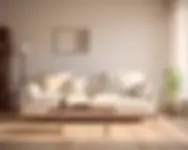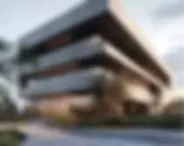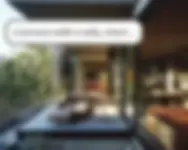Panorama Generator - Create Realistic 360° HDRI Panoramas with AI
Effortlessly convert any static architectural render or interior image into a high-quality 360° HDRI environment map. Built for architects, interior designers, and property marketers, this tool enhances presentations with fully navigable environments. All from a single input image. No 3D model, no stitching software, no hassle.
Selected module*
Exterior Render Generator
- Ensure your input image is high-resolution for the best results.
- Select Parameters
- Craft your prompt - Use keywords instead of sentences for clarity Keywords help the AI understand and create the desired look. (e.g., "modern house, glass facade, lush garden")
- Read this article about seed numbers to understand how they work and improve your renders.


Input image*
Error

360-degree full panorama HDRI environment map
• Upload your render: JPEG or PNG file, up to 15 MB for best quality.
• Press the button: Your 360-degree HDRI environment will be generated.
• Then, use your mouse to explore the scene interactively in full panorama.

- Click and drag to rotate the 360° map.
- Use the scroll wheel to zoom in and out.
Add paragraph text. Click “Edit Text” to customize this theme across your site. You can update and reuse text themes.











Before & After: Static Renders vs. AI-Generated 360° HDRI Panoramas
Balcony Panorama Transformation

From a simple balcony shot to an immersive HDRI panorama — AI enhances depth, lighting, and atmosphere, turning a static view into a cinematic architectural experience.
Countryside 360° Panorama

A rural landscape is seamlessly converted into a 360 HDRI environment map, preserving skies, terrain, and geometry — perfect for urban planning or VR simulations.
Interior-to-Skyline Panorama

AI expands an interior render into a photorealistic 360 panorama, blending indoor spaces with a sweeping skyline for architectural visualization and real estate marketing.
What Is an AI Panorama Generator?
An AI Panorama Generator is a specialized tool that transforms standard images, renders, or sketches into 360° HDRI environments. Unlike manual stitching or traditional panoramic photography, an AI panorama creation tool uses advanced algorithms to automatically align perspectives, generate depth mapping, and ensure seamless visual transitions.
The History and Development of Panoramic Imaging
Panoramic imaging has evolved from hand-drawn cylindrical landscapes in the 19th century to complex panorama stitching software and now to AI HDRI panorama generators. The shift from manual image merging to automated 360 panorama generators from images reflects the growing need for realistic HDRI environments in architectural visualization, gaming, and film. Today’s AI-driven workflows allow anyone to render to 360 panoramas online, bypassing the limitations of hardware-based panoramic photography.
How Does an AI Panorama Generator Work?
An AI panorama generator analyzes input images, such as renders or photos, and applies panorama stitching AI tools combined with depth mapping for accurate spatial geometry. The process involves perspective correction, HDR tone mapping, and equirectangular image generation for compatibility with VR and 3D rendering software. The result is a 360 HDRI environment map ready for use in Blender, 3ds Max, Unreal Engine, or architectural visualization platforms.
Key Benefits of Using AI for Panorama Generation
Speed, Accuracy, and Scalability
An AI HDRI panorama generator eliminates the slow, error-prone process of manual stitching. It delivers photorealistic HDRI converters in minutes, scaling seamlessly for projects of any size.
Cost and Time Efficiency
Instead of investing in expensive 360° camera equipment or outsourcing stitching services, firms can convert images to HDRI maps instantly using an online render to panorama converter.
Enhanced Client Engagement Through Immersive Views
Immersive 360 room view generators and virtual tour HDRI creations let clients experience spaces in full, helping them visualize designs beyond static images.
Consistency Across Multiple Views
AI ensures uniform lighting, tone mapping, and perspective correction, delivering consistent HDRI for architectural visualization across all projects.
Integration with Professional Architectural Workflows
The generator outputs HDRI for Blender, HDRI for 3ds Max, HDRI for Unreal Engine, and other 3D software, enabling smooth workflow integration with minimal post-processing.
Understanding Panorama and HDRI in Architectural Visualization
Differences Between Standard Panoramas and HDRI Panoramas
A standard panorama captures a wide scene but lacks dynamic lighting data. An HDRI panorama includes high dynamic range information, making it usable as a lighting environment map for architecture and 3D rendering software.
Comprehensive Overview of Different Types of Panoramas
Types include cylindrical, cubemap, and equirectangular panoramas. While cylindrical is common for prints, equirectangular HDRI projection is industry-standard for VR and 3D visualization.
Projection Methods Used in Panoramic and 360° HDRI Image Creation
The most common projection is equirectangular, often used with cubemap to equirectangular converters. Cylindrical projections remain relevant for architectural visualization when a less distorted field of view is required.
Technical Specifications and Workflows for Panoramas and HDRI Images
Technical Foundations of AI Panorama and HDRI Generation
Perspective Stitching & Depth Mapping Automation
An AI panorama generator automates panorama stitching and depth mapping, reducing human error. This makes convert images to 360 HDRI maps both fast and highly reliable, especially compared with traditional stitching software.
HDRI Lighting & Atmosphere Preservation
By preserving HDRI lighting for architecture, AI ensures that render to HDRI images retain a natural atmosphere. This is critical for interior design HDRI visualization as well as exterior architectural HDRI projects.
Texture & Material Detail Retention for Photorealism
Advanced AI models maintain surface accuracy during HDRI generation. For architects, this ensures that materials such as stone, wood, and glass remain true to life when converted via a photorealistic HDRI converter.
VR & Web-Ready Output for Real Estate Marketing
AI exports directly to VR-ready HDRI environment maps and web-optimized 360 panoramas. These are ideal for real estate HDRI virtual tours, allowing prospective buyers to explore properties interactively.
Real-Time Preview & Adjustments
Unlike traditional HDRI workflows, AI allows real-time HDRI previews. Architects and designers can instantly refine tone mapping, exposure, and perspective inside an AI panorama creation tool, speeding up project delivery.
Technical Methodologies for Producing HDRI Panoramas
HDRI Image Conversion Using AI Algorithms
AI-powered image to HDRI converters transform standard renders or images into photorealistic HDRI maps. This automation accelerates render to 360 panorama online creation, making it faster and more accurate than traditional manual workflows.
Depth Mapping for Precise Geometry and Scale
HDRI depth mapping ensures accurate spatial geometry in 360 HDRI environment maps. By preserving scale and proportions, architects can deliver architectural panorama presentations that feel immersive and dimensionally correct.
Perspective Correction to Fix Lens Distortion
AI tools automatically correct distortions and perspective issues, producing seamless equirectangular HDRI projections. This ensures HDRI for VR environments looks consistent and professional compared to traditional panoramic photography.
Multi-Image Stitching for Large or Complex Environments
When multiple renders or photo sets are combined, AI panorama stitching tools merge them into a single high dynamic range panorama. This is particularly useful in urban planning HDRI presentations, museums, and large-scale exhibition designs where accuracy across wide environments is essential.
Who Should Use AI Panorama Generation Tools?
Architects & Interior Designers
Design professionals use AI panorama creators to convert renders to HDRI images, producing immersive 360 room view generators that enhance client presentations.
Real Estate Developers
AI simplifies HDRI for real estate marketing, generating virtual tours that increase buyer engagement with photorealistic 360 panoramas.
Visualization Studios
Studios adopt HDRI generators for architects and panorama stitching AI tools to deliver high dynamic range panoramas for client pitches, branding, and film production.
Marketing Teams
Marketers leverage AI panorama generation vs traditional photography to produce immersive campaigns. AI HDRI maps enhance product launches, events, and interactive brand experiences.
Academic Institutions
Universities integrate AI panorama creation tools into curricula, preparing students to work with HDRI for Blender, HDRI for Unreal Engine, and HDRI for 3ds Max in professional visualization workflows.
Applications of AI Panoramas in Architecture and Beyond
Residential and Commercial Spaces
AI panorama tools enable the conversion of standard renders into 360 HDRI environment maps, allowing immersive exploration of homes, offices, hotels, and cultural venues. Clients can evaluate layouts, materials, and lighting in a more realistic way compared to static images.
Urban Planning and Masterplans
Planners use panorama stitching AI tools to visualize entire neighborhoods, districts, and public spaces in high dynamic range panoramas. These panoramic views help stakeholders understand connectivity, scale, and atmosphere, making urban proposals easier to communicate and approve.
Real Estate Marketing
With render to panorama converters, properties can be showcased through virtual tour HDRI creations, even before construction is complete. Interactive 360° walkthroughs boost buyer engagement, accelerate decision-making, and give developers a marketing advantage.
Exhibitions and Event Design
Museums, trade shows, and cultural events benefit from immersive HDRI environment maps that simulate visitor paths, exhibit layouts, and lighting setups. Event organizers use VR-ready HDRI outputs to refine spatial planning and reduce costly setup errors.
Entertainment and Digital Media
Beyond design, AI HDRI panorama generators are used in gaming, VR, film production, and product visualization. From creating skyboxes with cubemap to equirectangular converters to matching CGI lighting in movies, these tools power immersive digital experiences.
ArchiVinci AI Panorama Generator vs. Other AI Panorama Tools – Feature and Performance Comparison
Unlike generic converters, ArchiVinci’s AI panorama generator specializes in render to HDRI images, equirectangular HDRI projections, and photorealistic HDRI converters for architects. Compared with other tools, it provides higher resolution standards, professional HDRI file formats, and direct integration with rendering engines.
Best Practices for Creating High-Quality AI Panoramas
Prepare Input Images & Renders with Clean Geometry
The foundation of a strong AI HDRI panorama is a well-prepared source. Models or renders should be free of geometry errors, overlapping surfaces, or missing details. Clean input ensures the image to HDRI converter generates seamless 360° panoramas without distortion or stitching artifacts.
Choose Correct Camera Position & Field of View for Balanced Panoramas
Placing the camera at the correct height and selecting the right field of view is essential for creating natural, balanced panoramas. A central position allows the render to panorama converter to produce immersive HDRI images that feel spatially accurate in VR, real estate tours, or architectural presentations.
Maintain Accurate Lighting & Colors Using HDRI Tone Mapping Techniques
Lighting quality defines realism. By applying HDRI tone mapping techniques, designers ensure accurate brightness, shadows, and contrast across the panorama. Correct color balance is vital for photorealistic HDRI converters, keeping materials—wood, stone, glass—consistent and lifelike across different visualization platforms.
Frequently Asked Questions (FAQ)
What Is HDRI (High Dynamic Range Imaging)?
HDRI is a technique that captures a wider range of brightness levels than standard imaging. In panorama generation, it creates 360 HDRI environment maps with accurate lighting and contrast, making them essential for architectural visualization and VR environments.
What’s the Difference Between ArchiVinci AI Panorama Generator and Traditional Manual Stitching Software?
Traditional panorama stitching relies on manual alignment of images, which is time-consuming and prone to errors. The ArchiVinci AI Panorama Generator uses AI depth mapping, automated stitching, and equirectangular image generation, producing photorealistic HDRI converters in minutes with consistent quality.
Does AI Panorama Generation Work With Both Photorealistic and Stylized Architectural Renders?
Yes. ArchiVinci can convert architectural renders to HDRI maps regardless of style. Whether your render is photorealistic or stylized (sketch, watercolor, conceptual), the AI HDRI panorama generator preserves perspective, lighting, and materials.
How Does ArchiVinci AI Handle Complex Lighting Conditions Like Sunset or Mixed Artificial Light?
ArchiVinci applies HDRI tone mapping techniques and AI-based color correction to balance lighting conditions. This ensures accurate shadow detail and natural-looking highlights in sunset HDR panoramas or interiors with mixed light sources.
How Accurate Is Depth Mapping in ArchiVinci AI for Architectural Visualization?
ArchiVinci’s AI depth mapping is optimized for architecture. It maintains proportional geometry in 360 HDRI environment maps, ensuring spatial accuracy for walkthroughs in Blender, 3ds Max, and Unreal Engine.
How Do Projection Types Affect the Quality of AI-Generated HDR Panoramas?
Projection determines how the 3D scene is flattened into 2D. Equirectangular projections are standard for VR, cubemaps are popular in gaming engines, and cylindrical projections are best for panoramic presentations. ArchiVinci supports multiple projection types for different workflows.
How Important Is Bit Depth When Creating HDR Panoramas With AI?
Bit depth affects color precision and dynamic range. Using 16-bit or 32-bit floating-point HDRI image processing ensures accurate lighting and prevents banding in architectural panorama presentations.
What Are the Recommended Resolution Standards for High-Quality HDRI Panoramas?
For professional use:
-
4K: Basic visualization and web previews
-
8K: Interior walkthroughs and client presentations
-
16K: High-end visualization, VR, and large displays
What Output Quality Options (4K, 8K etc.) Are Available in ArchiVinci's AI Panorama Generator?
By default, ArchiVinci generates 2K panoramas. Users can upscale to 4K or 8K using the AI Render Enhancer. This makes it possible to export high dynamic range panoramas ready for VR and architectural visualization.
Are the Panoramas Generated by ArchiVinci Color-Calibrated for Printing Large-Scale Architectural Posters?
Yes. ArchiVinci supports HDRI color correction and calibration, ensuring EXR and HDR outputs are suitable for high-quality printing of architectural posters and design boards.
Can ArchiVinci AI Panoramas Be Used Directly in VR Headsets Without Additional Optimization?
Yes. ArchiVinci exports VR-ready HDRI panoramas in equirectangular projection. They can be directly used in VR headsets like Oculus, HTC Vive, or mobile-based VR systems.
Does ArchiVinci AI Support 360° Panoramas for Animated Walkthroughs or Only Static Images?
Currently, ArchiVinci outputs static HDRI panoramas. However, they can be integrated into animated walkthroughs using software like Unreal Engine or Unity.
Can ArchiVinci AI Output Both Cubemap and Equirectangular Formats in a Single Export?
Yes. ArchiVinci allows export in equirectangular HDRI projections and cubemap formats, ensuring compatibility across different rendering engines and gaming platforms.
Can ArchiVinci’s Panorama AI Tool Merge Multiple Camera Angles Into a Seamless HDR Environment Map?
Yes. Using multi-image stitching AI, ArchiVinci merges renders or photos from different camera angles into a seamless high dynamic range panorama.
Can ArchiVinci’s Panorama AI Tool Generate Both Day and Night HDR Environment Maps From the Same Scene?
Yes. By applying AI lighting variations, ArchiVinci can generate day/night HDR panoramas from the same render. This is ideal for client presentations showing design flexibility.
Can I Generate Multiple Lighting Variations (Day/Night) From the Same Panorama in ArchiVinci?
Yes. You can generate lighting variations like sunrise, sunset, or night mode using AI HDRI panorama generators, without creating new renders.
Can AI Panorama Generators Rebuild Missing Areas in Partial Panoramic Renders?
Yes. ArchiVinci uses AI inpainting techniques to fill missing sections in partial panoramas, producing seamless 360 HDRI environment maps.
Is It Possible to Generate Partial Panoramas or Focused Angles Instead of Full 360° Views?
Yes. You can export partial panoramas (360°) as jpeg file for more focused visualizations, useful in interior HDRI visualization or product staging.
How Do AI Panorama Generators Maintain Consistent Lighting Across Different Angles?
ArchiVinci uses AI HDRI lighting normalization and tone mapping techniques to ensure lighting consistency across panorama stitching and angle variations.
Can ArchiVinci’s AI Panorama Generator Support Multi-Exposure Bracketing for True HDR Output?
Yes. ArchiVinci supports multi-exposure HDRI merging, ensuring accurate highlights and shadows in high dynamic range panoramas.
What Is the Typical Processing Time for 4K or 8K HDR Environment Map in ArchiVinci?
On average, 4K HDR panoramas process in under 2 minutes, while 8K HDRI outputs may take 3–5 minutes, depending on scene complexity.
Can I Edit an ArchiVinci AI-Generated Panorama After Export for Additional Retouching?
Yes. Exported EXR or HDR files can be further refined in software like Photoshop, Nuke, or Affinity Photo, allowing advanced post-processing and retouching.
What Common Mistakes Occur in AI Panorama Generation and How to Avoid Them?
The most common mistakes in AI panorama generation are poorly prepared geometries, incorrect camera angles, overexposed lighting, and inconsistent colors. To avoid these issues, it is essential to prepare source renders properly, choose the right and balanced camera FOV, control lighting with HDRI-based tone mapping, and apply color calibration. This way, panoramas achieve a more realistic, consistent, and professional appearance.
What Are the Emerging Technologies and Future Trends in AI-Powered Panorama Generation?
Emerging technologies in AI-powered panorama generation include real-time HDRI creation for faster previews, generative AI tools that produce HDRI maps from text prompts, and adaptive HDRI depth mapping for more accurate geometry. In addition, integration with Metaverse platforms and VR/AR environments that surround the user with panoramic content is expected to broaden the applications of panoramic technology in digital spaces.
Can ArchiVinci AI Maintain Photorealism When Rendering From Non-Photorealistic Source Images?
Yes, the photorealistic HDRI converter refines stylized or conceptual renders, enhancing them with AI HDRI image processing to achieve a more realistic look.
You don't have enough credits.
Buy a plan to continue rendering